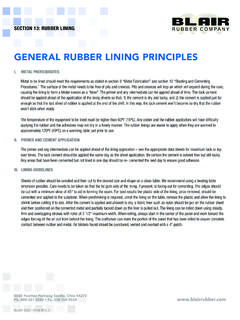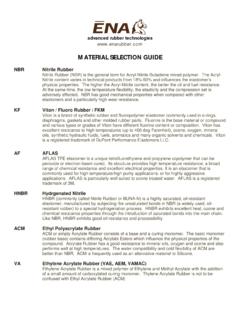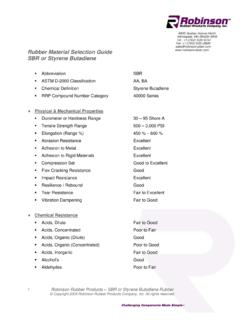Transcription of Splicing and Repair Manual - Rubber Tank Linings
1 Splicing andRepair ManualConveyor, elevator and transmission beltsDisclaimer ..Introduction.. Preparing for the splice ..Take-up position and weight ..Belt roll length and diameter ..Materials, Tools and Equipment..Curling Splice in a Vulcanizer..Making a Vulcanized Step Splice ..Cutting to length, required splicelength, direction of splice Medium Tension Belting..(without a breaker) Step by step procedureMedium tension/with a breaker ..Butyl and EPDM belts ..High Tension Belting..Reduced Ply Belts .. Steel Cable BeltingButt splice ..Overlap splice.
2 Splicing damaged or bare cables .. Splicing with unequal cables ..Light Weight Belting..Repairing Conveyor Belting.. Splicing Materials ..Glossary.. Tables1 Recommended take-up provisions ..2 Value K for automatic take-ups .. 3 Recommended splice material usage ..4 Estimating material requirements ..5 Materials factor ..6 One-ply knife recommendation ..7 Curing time for conveyor belting ..8 Curing time for plylock belt joint..9 Vulcanized splice-required belt length ..10 Work table for steel cable Splicing ..11 Laying out center line - steel cable.
3 12 Cable cutting pattern ..13 Splice materials arrangement - steel cable ..14 Cure times and temp for steel cable belt ..15 Cable arrangement - overlap splice#800, 1000, 1150, 1400, 1700 and 1800 .. 16 Cable arrangement - overlap splice#2100, 2400, and 2800 .. 17 Material and curing time -light weight belts .. 22 Factors determining whether beltshould be cut and spliced or repaired ..TABLE OF CONTENTSP lease visit us on the web at O. Box 4282 1252 Mina Avenue Akron, Ohio 44321 Phone: (330) 666-3600 Fax: (330) 666-9334 The Blair Rubber Company provides information, written and verbal, relative to belting which it hasgathered from a multitude of sources.
4 However, such information is offered as a guide only; andtherefore, Blair Rubber Company does not assume liability whatsoever, in regard to the use of user of this information must determine the suitability of this information, and if more informationis needed, the user should contact the appropriate belting the application of technical information supplied by Blair Rubber Company may be affected dra-matically by many factors such as, the length of exposure to a particular substance, the concentrationof any such substance, synergistic effects, exposure to more than one substance.
5 And/or a widerange of belting products and temperatures, the enclosed should only be used as a guide. BlairRubber Company, accordingly, disclaims liability for damages of any kind, including consequentialdamages, resulting from reliance on the information supplied INFORMATION12 This material has been designed to cover all aspects of splicingconveyor belting. We have taken a step by step approach usingthe methods and procedures proven over the years to providesplices with long trouble-free service. However, it should beemphasized that all splices, whether they be mechanical or vul-canized, are dependent upon three key factors that must be pre-sent in all splice work and these are:1.
6 Craftsmanship and procedures2. Proper materials3. Proper equipment and toolsOf these, craftsmanship is the most critical to success. The stepdown process is only as good as the splicer s technique. Caremust be taken while cutting along fabric planes that the plybelow is not nicked which can seriously reduce the overallsplice taking short cuts by reducing carcass step lengths orfill-in fabric used beneath each cover. These procedures are amust to provide satisfactory splice make sure the materials and the grade of belting you aresplicing are compatible with each other.
7 Use proper quantitiesas this is vital to a proper flow of materials and bonding duringthe vulcanizing expiration dates and throw away materials that are out-dated or , pay careful attention to equipment and should be checked on a routine basis to assure goodworking order to provide correct temperature and use tools designed for the task. As an example, ascrewdriver should not be used to separate fabric plies, it cangouge both plies and destroy them. Use a prodder prepare belt ends for Splicing in advance. Belting shouldbe prepared only when the Splicing process will be completed atthat are confident that by following the procedures found in thismanual, you will be able to achieve professional results and longtrouble-free service from your : Several procedures outlined in this manualinvolve varying degrees of physical risk.
8 Make sure equip-ment to be used is adequate for the job and is in good work-ing condition. Wear protective gloves/equipment whenworking with cutting tools, solvents, etc. When using sol-vents, be sure to follow safety precautions provided by theSpliceThe Splicing site- Splicing can bedone more easily on a horizontal runrather than on an incline. Considerthis when you choose the spot atwhich to pull the belt ends Splicing is restricted to an incline,it should be done at the lower endwhere the belt can be handled ll need a flat table to work on atthe Splicing site.
9 The table should beaccessible from both sides. If it isn t,build a temporary catwalk some installations, a permanentsplicing shanty offers protection forsplicing and repairs regardless of theweather. However, most customersprovide protection under temporarysplicing the conveyor is entirely off theground and several rolls of belting arerequired, consider making all splicesexcept the last one on the ground inline with the let-off facilities. Thefirst roll can be threaded onto the sys-tem and the trailing end spliced to thesecond. This can be repeated untilthe belt is completely last splice will have to be madeat some point on the conveyor the best place for Splicing is atsome point on the decking and severalrolls of belting are required, the beltcan be threaded by joining the sec-tions with temporary metal , when each mechanical splicereaches the Splicing station, the metalfasteners can be replaced by a vulcan-ized for Splicing - Beforeattempting either a mechanical or avulcanized splice, consider thesebasic the belt ends.
10 Make certainthat both ends are fresh . Neversplice with belt ends that have beendamaged or contaminated in back until you reach fresh Draw proper are basic to straight-run-ning splices. (They should be funda-mental to all Splicing .) Refer totable 9 for details on drawing making a mechanical splice,you can take advantage of the pre-cutparallel edges on all factory-slit belt-ing. Square each belt end by scribinga perpendicular line from one beltedge. (A common mechanic s squarecan be used here.) Before cuttingalong this line, scribe a second linefrom the other edge.











